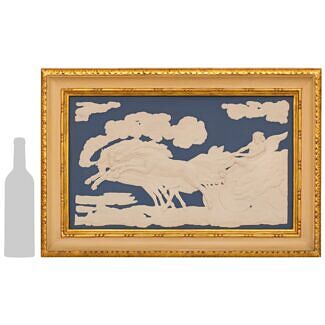A French 19th century Napoleon III Period Louis XVI st. Tulipwood, Kingwood, Sévres Porcelain and Ormolu Jardinière planter
List: $28,500.00
A stunning and high quality French 19th century Napoleon III Period Louis XVI st. Tulipwood, Kingwood, Sévres Porcelain and Ormolu Jardinière planter. This impressive three section jardiniere/planter rests on its wonderful Tulipwood base. The planter showcases a wonderful bombee shape... — Read More
A stunning and high quality French 19th century Napoleon III Period Louis XVI st. Tulipwood, Kingwood, Sévres Porcelain and Ormolu Jardinière planter. This impressive three section jardiniere/planter rests on its wonderful Tulipwood base. The planter showcases a wonderful bombee shape with a protruding front and rounded sides. The middle section contains a panel with butterfly veneers and a central reserve of a colorful oval Sévres Porcelain plaque of flowers mounted with a foliate decorated Ormolu frame. The panel is edged with a Coeur-de-Rain band and a Kingwood border. Both side panels are decorated similarly to the central panel. The top rim of this gorgeous planter is edged with an egg and dart Ormolu band as well as twisted metal band above. The interior contains the original fitted metal inserts with round handles on either side.
Shown with mirror item# 12905, sold separately. — Read Less
- Item # 13768
-
H: 13.5 in L: 72.75 in D: 18.5 in
H: 34 cm L: 185 cm D: 47 cm
- France
- 19th Century
- Kingwood, Metal, Ormolu, Porcelain, Tulipwood
- Louis XVI st. Read More, Napoleon III Period Read More
- Sèvres Read More
It was founded through the support of King Louis XV of France and at the initiative of Madame Pompadour to be located near her Château.
Due to Sèvres’ reputation for excellence and prestige, it has always attracted some of the best artists throughout history; François Boucher, Albert-Ernest Carrier-Belleuse, Étienne Maurice Falconet, Alexandre Fragonard and August Rodin, just to name a few. Many of these artworks can be seen at the Louvre Museum and the Musée National de Céramique in France.
Initially, Sèvres created a soft paste porcelain know as Biscuit de Sèvres. In 1768 the Bordeaux chemist Villaris and Jean Baptiste Darnet discovered deposits of Kaolin on French soil. In 1771 the Royal Academy sent a report on the creation of hard paste porcelain at which time Sèvres began manufacturing hard paste porcelain.
Louis-Simon Boizot (1743–1809) was a French sculptor renowned for creating Biscuit de Sèvres models, and was the director at Sèvres from 1774-1800, followed by Alexandre Brogniart(1800-1847) and Henri Victor Regnault in 1854.
Related products
-
# 8097 - H: 8" L: 17" D: 10"
-
# 5566 - H: 24" L: 38" D: 17"
-
# 12438 - H: 10" L: 31" D: 11"
-
# 8045B - H: 9" L: 37" D: 11"
Recently Viewed View All
-
# 13885 - H: 17" L: 25" D: 2"







































